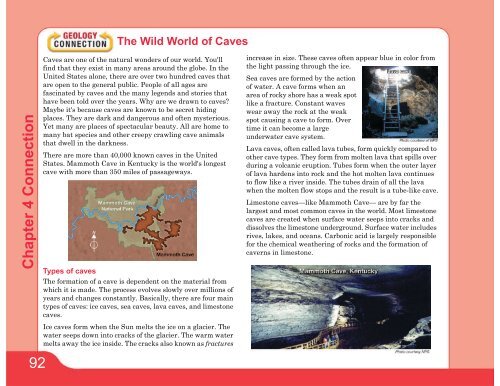Unit 2 Water and Weather - Spokane Public Schools
Unit 2 Water and Weather - Spokane Public Schools
Unit 2 Water and Weather - Spokane Public Schools
You also want an ePaper? Increase the reach of your titles
YUMPU automatically turns print PDFs into web optimized ePapers that Google loves.
The Wild World of CavesChapter 4 ConnectionCaves are one of the natural wonders of our world. You'llfind that they exist in many areas around the globe. In the<strong>Unit</strong>ed States alone, there are over two hundred caves thatare open to the general public. People of all ages arefascinated by caves <strong>and</strong> the many legends <strong>and</strong> stories thathave been told over the years. Why are we drawn to caves?Maybe it's because caves are known to be secret hidingplaces. They are dark <strong>and</strong> dangerous <strong>and</strong> often mysterious.Yet many are places of spectacular beauty. All are home tomany bat species <strong>and</strong> other creepy crawling cave animalsthat dwell in the darkness.There are more than 40,000 known caves in the <strong>Unit</strong>edStates. Mammoth Cave in Kentucky is the world's longestcave with more than 350 miles of passageways.Types of cavesThe formation of a cave is dependent on the material fromwhich it is made. The process evolves slowly over millions ofyears <strong>and</strong> changes constantly. Basically, there are four maintypes of caves: ice caves, sea caves, lava caves, <strong>and</strong> limestonecaves.Ice caves form when the Sun melts the ice on a glacier. Thewater seeps down into cracks of the glacier. The warm watermelts away the ice inside. The cracks also known as fracturesincrease in size. These caves often appear blue in color fromthe light passing through the ice.Sea caves are formed by the actionof water. A cave forms when anarea of rocky shore has a weak spotlike a fracture. Constant waveswear away the rock at the weakspot causing a cave to form. Overtime it can become a largeunderwater cave system.Lava caves, often called lava tubes, form quickly compared toother cave types. They form from molten lava that spills overduring a volcanic eruption. Tubes form when the outer layerof lava hardens into rock <strong>and</strong> the hot molten lava continuesto flow like a river inside. The tubes drain of all the lavawhen the molten flow stops <strong>and</strong> the result is a tube-like cave.Limestone caves—like Mammoth Cave— are by far thelargest <strong>and</strong> most common caves in the world. Most limestonecaves are created when surface water seeps into cracks <strong>and</strong>dissolves the limestone underground. Surface water includesrives, lakes, <strong>and</strong> oceans. Carbonic acid is largely responsiblefor the chemical weathering of rocks <strong>and</strong> the formation ofcaverns in limestone.92

















